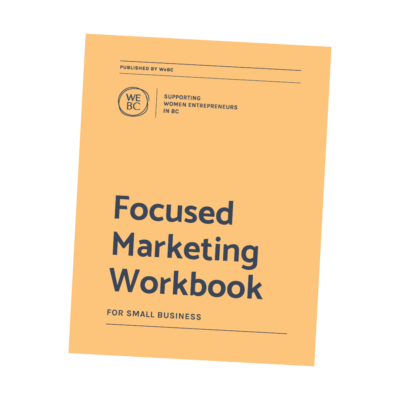Marketing Skills for Entrepreneurs: How to use a targeted marketing strategy to work smarter, not harder

As a Business Advisor, this is a common scenario: I have a call with a client and they want to know how to drive more sales for their business. Then they jump into potential solutions. Should I hire Instagram influencers? Shell out for Facebook or Google Ads? Should I put an advertisement in the paper or on the radio? Before you work on marketing tactics, you need to build your marketing skills.
To be fair, these are good questions and good ideas! But they fall into a very common trap—they assume all you need to do to drive sales is to tell more people about your product and persuade them to buy.
In other words, to advertise.
But marketing is so much more than just advertising. Marketing is about understanding your customer, developing the right product, putting the product in the right place, and pricing it correctly.
Promoting or advertising your product is just one tool in your toolbox, and sometimes, you need to take a more strategic approach. In this business skills post I’m going to write about how you can get out of the advertising trap and use all the tools in your marketing toolbox to reach your potential customers and (hopefully) get a sale.
Marketing Skills for Entrepreneurs: First, Marketing 101
If you took Business 101, you may have heard of a target market, which is the segment of your customer base that you’ve decided to focus on marketing to. You may have also heard about the four Ps of marketing, (Product, Price, Place, and Promotion), a.k.a. the Marketing Mix. Think of these as the tools in your marketing toolbox that you can use to reach your audience.
In a business textbook these concepts are about as exciting as doing your taxes, but when you thoughtfully combine knowledge of your target market with the tools of the four Ps, it’s a powerful combination to unlock new ideas for your business.
Target Markets – Everyone is not your customer
Finding your target market starts with market segmentation. This means asking questions to understand the characteristics of the people you want to market to:
- What are their demographics?
- How do they make spending decisions?
- What are they interested in?
- What is important to them?
Sample:
Using an eco-friendly skincare business as an example, you may end up with a target market description that looks like this:
- Professional/working women aged 35-45 living in Canada.
- Household income of over $100,000.
- Values environmental and social causes.
- Likes to research a lot before making purchasing decisions.
- Likes to share on social media and stay up-to-date on trends.
To segment your market effectively, make sure to do your market research to back up your assumptions. Who is actually purchasing the most of your product? How much do they spend? Where do they live? Dig in and you might be surprised.
If you’re like most businesses, you will come up with more than one target market. That’s fine, but try to narrow it down to just one or two segments for your marketing efforts. Don’t fall into the trap of saying that everyone is your target market.
The point of finding your target market is to identify your ideal customer. This is a person who will buy from you often, engage with your message, and hopefully, tell a friend!
This helps your marketing efforts go further (saving you time and money). There are lots of tools online to help you refine your target market, so get started! Now that you’ve got your target market in mind it’s time to apply the marketing mix.
Product – You are not your customer
You may have heard this one before—“You are not your customer.” This is especially relevant when it comes to product and product strategy.
Often a business owner will start their business based on developing products and services that they themselves want or need. Maybe you created a product that you love, and think other people will love it too.
Great! You identified a need!
But to make your business grow and thrive, you need to shift away from a product-focused mindset (people are going to love the awesome skin lotion I created) and towards a customer-focused mindset (what are the needs and wants of my target market and what products fill that need?)
How can you do that? It’s relatively easy—ask your target market about their wants and needs, and then listen. What new products can you add or adjust? What products should you retire? Can you offer different varieties or packages?
Price – Your product is worth what someone will pay for it
Price sometimes gets overlooked as a part of marketing strategy—but it’s a crucial part of how a customer decides to buy from you. When it comes to pricing, there are some fundamental financial considerations that will constrain how much you can charge. You need to charge enough to cover your expenses and make a profit, but there are other variables to play around with.
Build your marketing skills: Here are some things to think about:
- Try to understand your target customer’s willingness to pay. What is the most they will pay for your product, and at what point do you risk coming across as a lower-quality product compared to your competition? If you’ve identified that your customer values quality over price, trying to get more sales by undercutting your competition is probably going to backfire.
- Create a strategy for sales and markdowns. They say that everyone loves a sale, but is that true for your target market? If you use discounts and markdowns to try to improve sales, you may be training your customers to wait for sales. This can be a sound approach, but only if it’s tied to your overall business strategy and you can still make a profit while doing it.
- Be strategic about shipping. Most businesses need to build shipping costs into their pricing strategy. What approach is best for your target market? Free shipping? Flat rate? Customer pays in full? Some customers will back out of the transaction if they have to pay for shipping, but others aren’t bothered in the least. What approach is best for your target market?
Place – Location, location, location!
The next element in the marketing mix, Place, is about more than just where to sell your product—it’s about all of the elements that come into play to get your product into the hands of your consumer in a timely and cost-effective way.
Build your marketing skills: How can you re-think your Place strategy to better meet the needs of your target market?
- Consider your channel strategy. Some customers will prefer to buy your product through a direct channel—that is, directly from you. This may help make sure they have access to customer support and feel more confident in their purchase. Other customers may prefer an indirect channel, such as buying from an unaffiliated website or retailer. They may prefer this approach because it allows them to consolidate their purchases or because it’s just more convenient. The key is to determine what channel your target market prefers and incorporate that into your overall channel strategy.
- Help your customer find your product. Consider your target market when you design your sales environment. What kind of design elements and branding do they relate to? How can you organize your shop or website to help them find what they’re looking for? What purchasing support or nudges can you provide throughout the purchasing process? Some target markets will appreciate a hands-on sales experience, while others might just want to be left alone. Figure this out for your target market and think of how to execute on that approach.
Promotion – Build relationships that last
We’ve arrived at the last “P,” Promotion, which is how this post got started. As I mentioned, many clients are quick to jump to advertising solutions when looking to drive sales, and sometimes, these solutions are expensive, time consuming, and questionably effective.
But promotion is more than just advertising—it involves all the things you do to communicate with your target market and (eventually) persuade them to buy.
Build your marketing skills: How can you use what you know about your target market to do promotion better?
- Build a relationship. Marketing communications is about building a relationship with your target market, not just trying to drive a transaction. Use your marketing communications to tell your brand’s story in a way that resonates with your target market. Tell a story about your product that aligns with their values, and incorporate that with other more sales-driven promotions. Think of it like planting seeds: each meaningful engagement you have with your target market has a chance of growing into a sale. Be patient and consistent with your brand to harvest sales down the road.
- Use the right kind of media. Your target market likely trusts messages from some sources more than others. How can you target those sources instead of taking a more scattershot approach (i.e. Facebook and Google Ads). Maybe you can approach micro-influencers in your area, set up a pop-up shop in a local boutique, or provide word-of-mouth referral bonuses to encourage people to tell their friends? If you had to get a sale tomorrow, what would you do? The answer to this question can give you a hint about how you can actually reach your customers.
Your Target Market-focused marketing strategy
Trying to drive more sales to your business? Who isn’t!
No matter where you’re at in your business, it might be worthwhile to take a step back and thoughtfully apply the marketing mix to your target market. Have an open mind and consider how your overall business strategy might benefit from some tweaks (or bigger shifts!) in how you approach Product, Price, Place, and Promotion. You can flex your marketing skills, and your target market will thank you!

Focused Marketing Workbook
Do you feel tired and frustrated at the amount of money and effort this marketing requires? What if you could find a way to reduce the scatter, efficiently manage your time and get better results?



